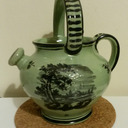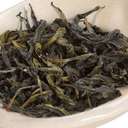Tea: Grand Pouchong Oolong
A Pouchong Tea from Simon Lévelt
| Brand: | Simon Lévelt |
| Style: | Pouchong Tea |
| Region: | Taiwan / Formosa |
| Caffeine: | Caffeinated |
| Loose? | Loose |
| # Ratings: | 1 View All |
| Product page: | Grand Pouchong Oolong |
Reviewer: Teuvo

✓ 63 teas reviewed
✓ 1 of Pouchong Tea
✓ 10 of Oolong Tea
✓ 12 of Simon Lévelt
✓ 3 from Taiwan / Formosa
Review of Grand Pouchong Oolong
November 25th, 2017
| Aroma | Flavor | Value | Total |
| 8 of 10 | 4 of 5 | 3 of 5 | 76 of 100 |
| Excellent | Good | Reasonable |
My friend gave me some of this tea to try.
I'm not good at tasting the difference between different greenish oolongs. Jade oolong, four seasons, Tie Guanyin, they often taste almost the same to me. It was the same with this one at the first steeping.
The second cup tasted different, though, like jade oolong but greener. It reminded me of Mao Feng green tea.
I hardly even paid attention to the flavour and aroma of the third cup because that one had a really strange mouthfeel. Sometimes teas feel a bit thicker than water; Het Gouden Randje's Bản Liền green tea, for example. However, this one felt extremely thick and almost viscous. I couldn't quite decide if it was pleasant or not.
Fourth steeping: It still feels a bit thicker than water, but not strikingly so. I'm wondering if it really was something about the tea that made it feel so strange the previous time or just something else. Anyway, it still tastes like a mix of jade oolong and mao feng. Mostly smooth but with a bright vegetal aroma as well. The colour is a lovely bright greenish yellow.
Nothing new in the fifth, sixth, and seventh steepings. The eighth one has this kind of dull sweetish aroma/flavour that usually means tea leaves are spent. From here on I can still get more or less enjoyable tea from it, but I'd say seven is a very decent amount of cups from the same leaves already.
I brewed this by putting a few teaspoons (about three) in a teapot, poured boiled water into the pot and then immediately poured the tea into the cup. This method works pretty well for my everyday tea. (Usually after the second or third cup, I let it steep for longer.)
This is pretty expensive at €7.40 for 50 grams.
Add your own review
Comments:
| Alex Zorach wrote: on November 27th, 2017 |
I also struggle with distinguishing the nuances of the various green oolongs. I definitely have tried a number of green oolongs of different varietals to taste very similar. Part of this may be that the overall flavor and character of an oolong is more a function of the production method, than the particular cultivar or influences of terroir or climate.
To me though, pouchong / bao zhong usually tastes recognizably different from the other green oolongs. The lower grades of pouchong often have more of a seaweedy / oceany quality that is usually absent from the other green oolongs that are in shape of tightly-rolled balls. Sometimes they even taste fishy to me. At all grades, they taste more overtly vegetal to me and, although they are often somewhat floral, they usually smell less overtly orchid-like than Tie Guan Yin, Ben Shan, and any number of other green oolongs. Pouchongs often taste to me like I have added honey to them...more so than other green oolongs. The other oolongs, when they have "off" aromas, I'm more likely to perceive them as "soapy" than "fishy". Also, especially in later steeps, the other oolongs seem to develop more herbaceous notes, suggesting celery-family plants (celery, parsley, etc) and I rarely notice these notes in pouchongs.
I also noticed that you described this as being a little bit like mao feng. In general pouchong tastes more like green tea (esp. Chinese green teas like mao feng), to me, than the other green oolongs, which, in spite of their green color, rarely tastes anything like green tea to me.
This is all just my own experience, my attempts to put into words the various smells and sensations I get when drinking these teas...other people may read what I wrote and be like "huh? I don't get that at all".
So I'm not sure if this is going to be at all helpful to you, but perhaps you can notice some of these things?
If you want to try some green oolongs that really jump out as having some sort of different quality that is more easily recognizable, I would point you to Mao Xie (Hairy Crab), Huang Jin Gui (Golden Osmanthus), or Shui Xian (Water Sprite or Narcissus), if you can find Shui Xian in a green version. All of these have stood out to me as different from Tie Guan Yin...whereas some of the others, including more what you've sampled / reviewed on this site, are the ones that seem to blend together to me as being less distinct.
| Teuvo wrote: on December 1st, 2017 |
If nothing else, I feel reassured that even you have trouble distinguishing between different green oolongs!
And I do recognise some of what you say. Rolled green oolongs like Het Gouden Randje's Formosa Jade Oolong sometimes do taste soapy to me, but not consistently, so it's probably due to less than entirely successful attempts at making the tea.
The thing I find most difficult about reviewing teas is describing the aroma. I readily believe that Tie Guanyin smells like orchids, or that some other tea tastes like wintergreen, but I have no idea what either orchids or wintergreen smell or taste like, to name just two examples. I know it's useful to describe the aroma in terms of other things it smells like, but I can't really think of anything... I just try not to make my descriptions too synesthetic.


